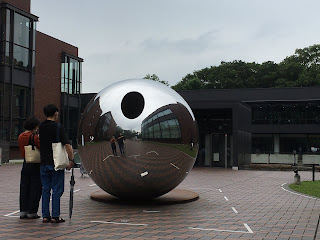For those starved of culture during the lockdown, the reopening of the Tokyo Metropolitan Art Museum on July 23rd featuring a brand new ukiyo-e exhibition was a moment for celebration. The museum is located in Ueno Park which contains a host of other world class museums as well as Ueno Zoo and some impressive temples and shrines (plus the famous statue of "Last Samurai" Saigo Takamori covered here and the rather lovely Shitamachi museum introduced here). The entrance to the Metropolitan Art Museum is famous for the giant stainless steel sculpture entitled “my sky hole 85-2 light and shadow” created in 1985 by Bukichi Inoue which magically reflects everything around it.
So what are ukiyo-e? Ukiyo-e are basically woodblock prints for mass consumption created during the Edo period (1603-1868). The term "ukiyo" (浮世) is made up of the characters for "floating" and "world" and carries the sense of transient, hedonistic everyday pursuits enjoyed by ordinary people during what was a peaceful, thriving period in one of the world's biggest cities. Much like modern fashion/celebrity magazines, they featured beautiful courtesans, famous Kabuki actors, and strapping sumo wrestlers - the style leaders of the time. Starting off as black ink prints, colour was gradually introduced together with Western style perspective. Later prints featured some stunning landscapes, such as Great Wave off Kanagawa by Hokusai probably the best known ukiyo-e print in the world. In these landscapes, nature and climate become an important element: in particular, the snow/moon/flower (setsu-gekka =雪月花) theme, representing (like haiku) the seasons of winter, autumn, and spring (cherry blossoms) crops up quite regularly.
 |
| Morning snow at Yoshiwara, Moon over Sumida River, and Viewing Cherry Blossoms along the Sumida River all by Hiroshige. From Library of Congress (no known restrictions on publication - see Jim Breen's position on copyright here) |
Another thing I noticed while looking over the 450-odd pictures in the exhibition was the obsession with beauty and the "ideal" Japanese woman. In fact, hair styles aside, the ideal appeared to change very little from Moronobu's 1680 "Two Lover's Embracing" through Kitagawa's 1792-93 "Three famous Beauties" (pictured) to Kikukawa's early 19th century "July". Invariably, women were represented as having a doll-like beauty, tall, willowy, graceful, and elegant with an elongated face, narrow, widely spaced eyes, a long, flat nose, and large ears which were always visible. Eyebrows were usually high and artificial - or completely shaved off (apparently the sign of adulthood, marriage, and/or having a child - see here). Lips were tiny, painted rouge, and consistently pursed shut - no smile or teeth are to be seen (though Kitagawa does have a picture of a woman blackening her teeth here).
A final noticeable feature of the bijin-ga (beautiful woman pictures) is the pure white (irojiro =色白), smooth, unblemished skin. In the age of Black Lives Matters, it might be tempting to jump to the conclusion that this reflected a Caucasian ideal; however, ukiyo-e predates the phenomenon of akogare or adoration/looking up to the West: Western (white) beauty as the ideal, as seen in the portrayal of Japanese with Caucasian features and fashion, only began during the Meiji Era (1868-1912). Russel notes that the Japanese have traditionally viewed their skin as white, only later coming to see themselves, at least
rhetorically, as members of “the yellow race." One reason that was said to be considered beautiful at this time, not only in Japan but across Asia, was the fact that those working outdoor in the rice fields tended to have darker skin, denoting a "lower class." As you ponder whether beauty is indeed skin deep, I'll leave you with one of my favourite ukiyo-e which shows that humour too was a feature of many of the images!
 |
| Utagawa Kuniyoshi's "Young Woman who Looks like an Old Lady" |



No comments:
Post a Comment